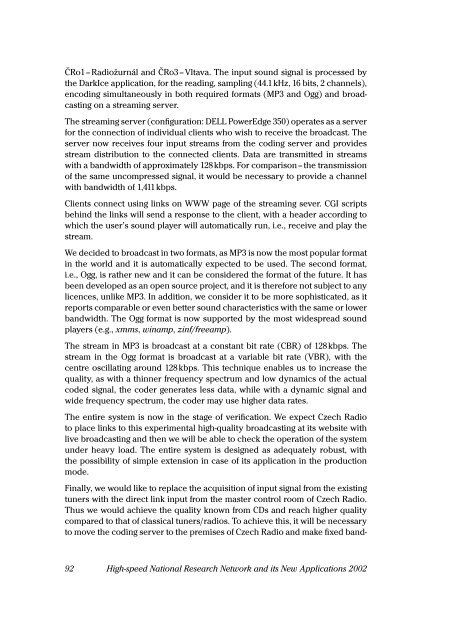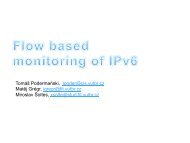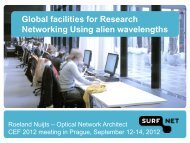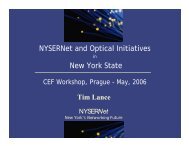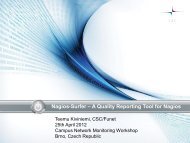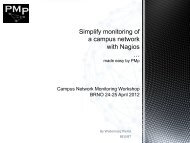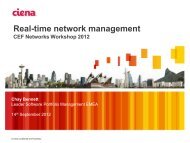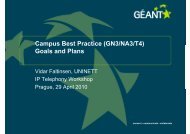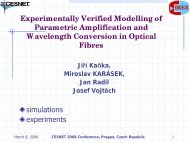2002 - cesnet
2002 - cesnet
2002 - cesnet
Create successful ePaper yourself
Turn your PDF publications into a flip-book with our unique Google optimized e-Paper software.
ČRo1 – Radiožurnál and ČRo3 – Vltava. The input sound signal is processed bythe DarkIce application, for the reading, sampling (44.1 kHz, 16 bits, 2 channels),encoding simultaneously in both required formats (MP3 and Ogg) and broadcastingon a streaming server.The streaming server (configuration: DELL PowerEdge 350) operates as a serverfor the connection of individual clients who wish to receive the broadcast. Theserver now receives four input streams from the coding server and providesstream distribution to the connected clients. Data are transmitted in streamswith a bandwidth of approximately 128 kbps. For comparison – the transmissionof the same uncompressed signal, it would be necessary to provide a channelwith bandwidth of 1,411 kbps.Clients connect using links on WWW page of the streaming sever. CGI scriptsbehind the links will send a response to the client, with a header according towhich the user’s sound player will automatically run, i.e., receive and play thestream.We decided to broadcast in two formats, as MP3 is now the most popular formatin the world and it is automatically expected to be used. The second format,i.e., Ogg, is rather new and it can be considered the format of the future. It hasbeen developed as an open source project, and it is therefore not subject to anylicences, unlike MP3. In addition, we consider it to be more sophisticated, as itreports comparable or even better sound characteristics with the same or lowerbandwidth. The Ogg format is now supported by the most widespread soundplayers (e.g., xmms, winamp, zinf/freeamp).The stream in MP3 is broadcast at a constant bit rate (CBR) of 128 kbps. Thestream in the Ogg format is broadcast at a variable bit rate (VBR), with thecentre oscillating around 128 kbps. This technique enables us to increase thequality, as with a thinner frequency spectrum and low dynamics of the actualcoded signal, the coder generates less data, while with a dynamic signal andwide frequency spectrum, the coder may use higher data rates.The entire system is now in the stage of verification. We expect Czech Radioto place links to this experimental high-quality broadcasting at its website withlive broadcasting and then we will be able to check the operation of the systemunder heavy load. The entire system is designed as adequately robust, withthe possibility of simple extension in case of its application in the productionmode.Finally, we would like to replace the acquisition of input signal from the existingtuners with the direct link input from the master control room of Czech Radio.Thus we would achieve the quality known from CDs and reach higher qualitycompared to that of classical tuners/radios. To achieve this, it will be necessaryto move the coding server to the premises of Czech Radio and make fixed band-92 High-speed National Research Network and its New Applications <strong>2002</strong>


